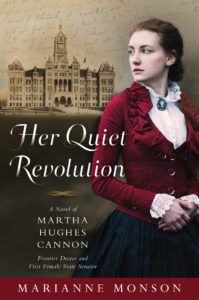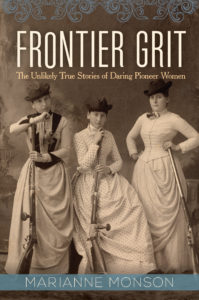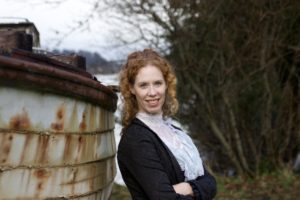 A guest post by Marianne Monson.
A guest post by Marianne Monson.
In 2015, I was working on a book of mini-biographies about incredible pioneer women who had been largely overlooked by history; during the research, I came across the story of Dr. Martha Hughes Cannon. Cannon had not only attended University of Michigan medical school a few years after they began accepting female candidates, but then went on to run for the office of State Senator 24 years before women could vote in the United States. She ran for this office against Emmeline B. Wells and against Cannon’s own husband, Angus M. Cannon. Martha won.
I’d attended BYU where I earned an English degree before completing my MFA in Creative Writing from Vermont College of Fine Arts and spent the last several years writing on topics related to pioneer era women’s history, but I had never heard Cannon’s story before. How had her remarkable accomplishments been overlooked? Answering that question remains a difficult one, though my conjecture is it has to do with the fact that she was affiliated with the Democratic party during an era when members of the church increasingly identified as Republican. While in office, she also refused to align herself with positions for which her husband, a prominent church leader, vehemently advocated. Certainly her legacy was further complicated by the fact that she didn’t hold prominent callings in the church and eventually moved to California, where she continued teaching Sunday School into her final years of life.
 The resulting book, Frontier Grit: The True, Untold Stories of Daring Pioneer Women, came out with Shadow Mountain in 2016, and helped increase awareness of Cannon’s story. Then as the 100-year anniversary of US women’s suffrage approached, Neylan McBain began the Better Days 2020 project to raise awareness of the role Utah women played in the national suffrage struggle, and Cannon was one of the women they chose to highlight (complete with a “Send Martha to DC campaign” that resulted in a commissioned statue of Cannon being unveiled in the nation’s capital this fall).
The resulting book, Frontier Grit: The True, Untold Stories of Daring Pioneer Women, came out with Shadow Mountain in 2016, and helped increase awareness of Cannon’s story. Then as the 100-year anniversary of US women’s suffrage approached, Neylan McBain began the Better Days 2020 project to raise awareness of the role Utah women played in the national suffrage struggle, and Cannon was one of the women they chose to highlight (complete with a “Send Martha to DC campaign” that resulted in a commissioned statue of Cannon being unveiled in the nation’s capital this fall).
As projects were planned to commemorate the anniversary, my editor asked if I would be interested in drawing on previous research and writing a historical fiction novel based on Cannon’s life. Given that Shadow Mountain would be the publisher, I sought assurance that I would have full reign to portray the details surrounding Cannon’s life, particularly her practice of polygamy, with complete historical accuracy. When my editor assured me I would, I agreed to take on the project. I then began the work of examining remaining primary source documents, which largely take the form of letters as Martha requested that her journals be burned upon her death.
Of course, writing a novel is very different from writing a short biography, and to bring Cannon’s story to life, I needed to dive into the details in a different way, seeking to bring both her immediate environment and the broader scope of her life’s work into focus. A professional development grant from Clatsop Community College allowed me to travel to Llandudno, the small town on the northern coast of Wales where Cannon was born. In that lovely area, I retraced Cannon’s steps through the country, writing on location in a circle of ancient yew trees and in a graveyard where I knew she had once paid homage to her ancestors’ remains. The pilgrimage brought Martha’s Welshness to life—her love of poetry, of classical literature, of theater, and music.
The trip also exposed me to the tradition of Welsh “cunning women,” simple village healers who drew on their knowledge of herbal medicines and plants as they practiced the healing arts. Near the town of Llanddoged, where Martha’s ancestors lived, a cunning woman named Gwen Ferch Ellis was accused of witchcraft in the 1500s and put to death in the public square. I held Gwen’s actual 16th century trial documents in the National Library in Aberystwyth and became fascinated by a potential connection with Martha’s grandmother, whose husband worked as a gardener. By envisioning her as a cunning woman, I was able to connect the two stories during Martha’s visit to Wales while exiled from Utah during the federal persecution of polygamy
I similarly connected Martha’s participation in female-led healing ordinances, the LDS women’s confinement ritual, and the concept of the divine feminine to ancient Celtic practices of yew trees and wells, the latter having symbolized life-giving wombs since ancient times. To my delight, Shadow Mountain followed through on their promise and sent the book to press without any alterations to content. As far as I know, this is the first book to fictionally portray LDS female healing and confinement rituals, which were beautiful, often overlooked, features of our faith during those years.
It was an incredible privilege to bring Martha’s story to life. Her Quiet Revolution was released in February 2020, which seems fitting given that as a state senator, Dr. Cannon dedicated her legislative work to advancing issues of public health. In addition to advocating for increased access to clean water, improved sanitation, and vaccinations to prevent outbreaks of disease, she also helped establish Utah’s first State Board of Health, on which she served. Dr. Martha Hughes Cannon is a woman who grappled with many challenges still surprisingly relevant 150 years later, and it was a joy to translate her remarkable accomplishments into fiction.

See a video of Marianne Monson talking about Martha Hughes Cannon here.
Marianne Monson is the author of eleven books for children and adults. She holds a degree in English Literature from BYU and an MFA in Creative Writing from Vermont College of Fine Arts. She is founder and president of the literary nonprofit The Writer’s Guild, and she writes on topics related to women’s history in the pioneer era from a 100-year-old house in Astoria, Oregon. www.mariannemonson.com.

.
Wow. This is. Very exciting.